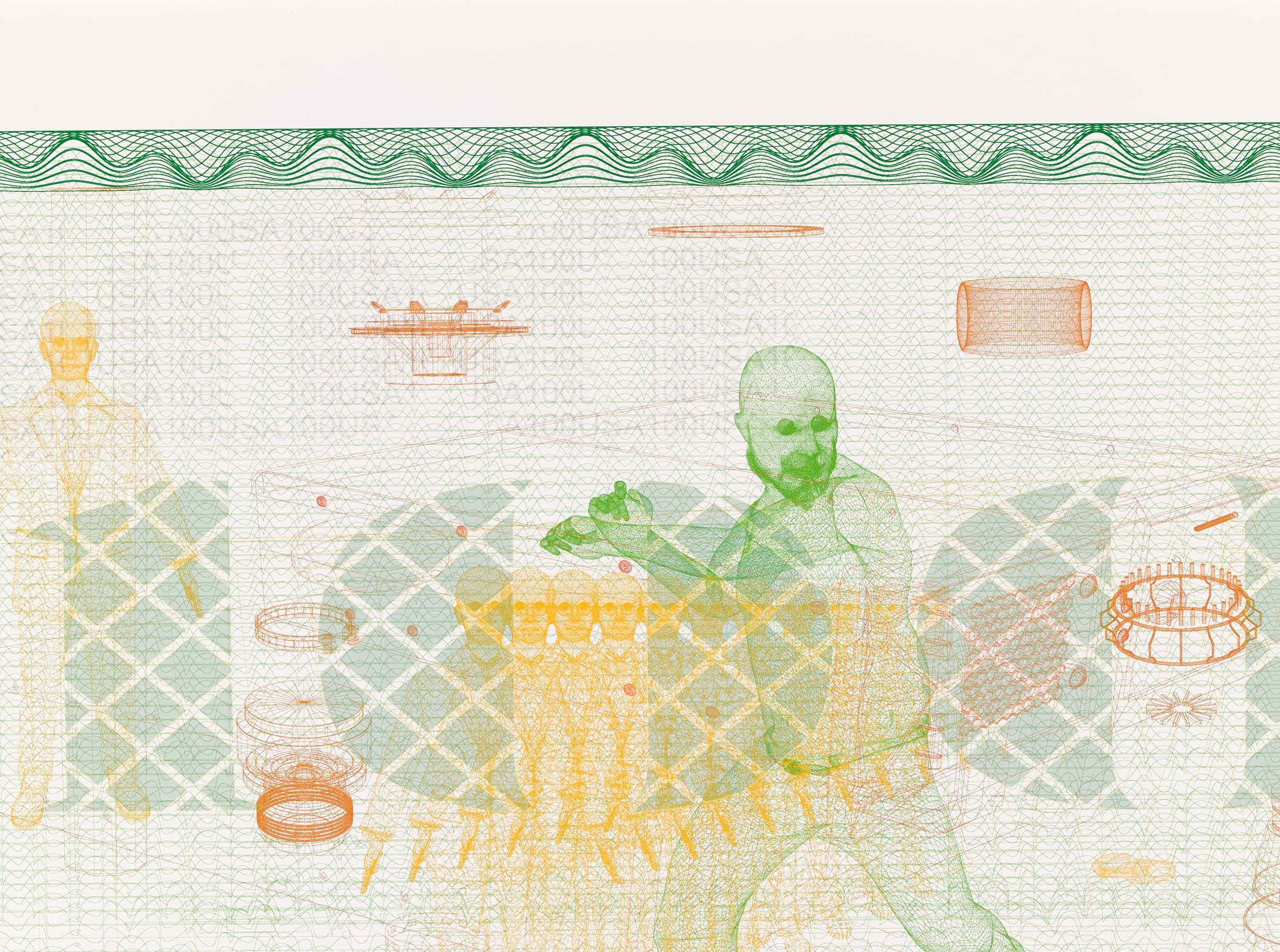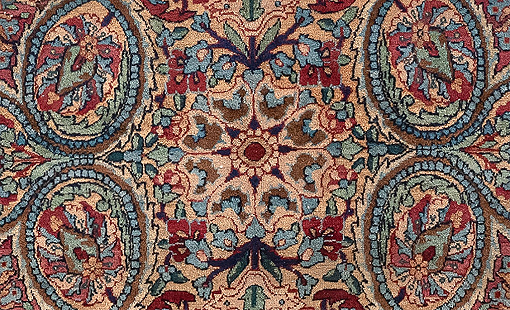
Selection of rugs and textiles held by Banco de España added to online Collection section
Over its more-than-two-hundred-year lifetime, the Banco de España has amassed a considerable art collection. As part of its efforts to make this collection available to the public, the Banco de España has taken a number of actions to further the investigation, cataloguing and dissemination of the valuable items contained in the decorative arts section. The first was the publication in April 2023 of a catalogue raisonné of its collection of timepieces, covering a selection of 143 of the most representative pieces held by the bank and featuring details of the makers, place of manufacture, time scale, measurements and other relevant information on each item.
A selection of these timepieces was also included in the Collection section of the bank's website as the first part of a subsection devoted to decorative arts. That subsection is now being extended with two further headings: rugs and textiles. We plan to continue adding content in the coming months, with more unique items from the bank's collection of what used to be known as the 'minor arts', e.g. furnishings and ceramics. One of the main reasons why what is now the Banco de España Collection was set up was to obtain decorative and art objects to enhance workspaces and set off the architecture of the Bank at its central headquarters and branch offices. These pieces have played an essential role in fulfilling that aspiration.
 Gerard Peemans. Series of tapestries on the months of the year (c. 1679). January-February | March-April | May-June | July-August | September-October | November-December
Gerard Peemans. Series of tapestries on the months of the year (c. 1679). January-February | March-April | May-June | July-August | September-October | November-December
The Textiles section initially features a series of six tapestries themed around the months of the year, produced by Flemish master weaver Gerard Peemans in the late 17th century. They were acquired by the bank in 1933 as part of a refurbishment project drawn up by architect Juan de Zavala to help improve the acoustics in the boardroom at the bank's headquarters on Plaza Cibeles, where they are still housed. Ángel Aterido explains that in these tapestries the months are grouped in twos and represented by female figures, accompanied by the corresponding signs of the zodiac and surrounded by groups of cherubs or winged children playing with the flowers and fruits found in each season. They are paradigmatic examples of the output of the Flemish Tapestry Works of the time, which was much appreciated in the decoration of palatial homes throughout Europe.
The iconography used in depicting the months is based on that created between 1647 and 1649 by Jan van de Hoecke for a commission from Archduke Leopold Wilhelm of Austria, but incorporates the subsequent modifications to the original cartoons made by painter and engraver David Teniers III. Several sets of this series were produced on Gerard Peemans' looms, but only this one held by the Banco de España and another at Prague Castle are known to have survived in their entirety. The coat of arms of the city of Mons (Bergen in Dutch) appears below the panels with the names of the months. This identifies the set as being the one made by Peemans under a commission for Carlos de Aragón Gurrea y Borja, 9th Duke of Villahermosa, as in 1678, during his term as governor of the Low Countries, the Spanish aristocrat had raised the French siege of the city. For this achievement, he was awarded the order of the Toisón de Oro ['Golden Fleece'] by King Charles II of Spain.
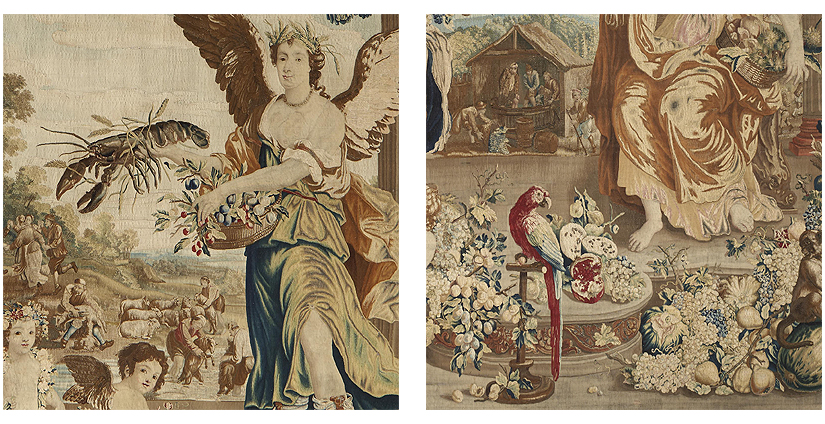 Gerard Peemans. Details of the tapestries for May-June and September-October (c. 1679)
Gerard Peemans. Details of the tapestries for May-June and September-October (c. 1679)
Two of these tapestries - those for May-June and September-October- were included in the Flowers and Fruits exhibition, which ran from 26 October 2022 to 25 February 2023. Using a selection of works from the Banco de España's collection in different formats and from different periods, this exhibition analysed how the style of still-lifes has changed over time, highlighting the frequent use of plant motifs as allegories for core aspects of life and death.
The Collection section of our website now also includes a specific subsection on rugs with a selection of the most outstanding historic examples owned by the Banco de España. Six are from a large group of rugs in our collection produced by the Real Fábrica de Tapices![]() ['Royal Tapestry Works']. The oldest of them dates from 1867 and is described by Antonio Sama, author of the catalogue, as an 'excellent example of the magnificent Queen Isabella style' produced at the works. The Royal Tapestry Works opened in 1721 and is still operating today, though since 1996 it has been run as a private, not-for-profit foundation. This rug was made towards the very end of Queen Isabella II’s reign. Sama states that its bright, mottled colours are 'fully consistent with the style of nineteenth century ornamentation'.
['Royal Tapestry Works']. The oldest of them dates from 1867 and is described by Antonio Sama, author of the catalogue, as an 'excellent example of the magnificent Queen Isabella style' produced at the works. The Royal Tapestry Works opened in 1721 and is still operating today, though since 1996 it has been run as a private, not-for-profit foundation. This rug was made towards the very end of Queen Isabella II’s reign. Sama states that its bright, mottled colours are 'fully consistent with the style of nineteenth century ornamentation'.
 Real Fábrica de Tapices - Fábrica Nacional de Tapices ['Royal Tapestry Works - National Tapestry Works']: Rug (1867) | Rug (1932)
Real Fábrica de Tapices - Fábrica Nacional de Tapices ['Royal Tapestry Works - National Tapestry Works']: Rug (1867) | Rug (1932)
The second oldest piece is the large knotted rug on the floor of the committee hall at the bank's headquarters on Plaza Cibeles. Produced between 1900 and 1925, this is one of the many rugs made at the Real Fábrica de Tapices that imitate oriental styles, as was fashionable around the turn of the 20th century. Three rugs from the 1930s have been selected for inclusion. Two of them, inventoried as No. 244 and No. 264, are characterised by the fact that they are most heavily decorated on their borders. Antonio Sama writes that their designs look to be by Faustino Álvarez Quintana or one of the other sketch artists working at the Tapestry Works during the Second Republic (when it was renamed ‘Fábrica Nacional de Tapices’ [National Tapestry Works]). These artists sought to modernise and renovate historical styles of decoration, leaning towards abstract forms that tied in with Art Deco sensitivities. This quest for renovation can also be seen in the third rug from the 1930s selected, with its flat, non-nuanced colours and simplified, almost naive outlines, far removed from classical tradition. The sixth and final piece selected is a knotted rug made in 1943, with a composition that recalls grotesque-style decoration and the paintings of Pompeii.
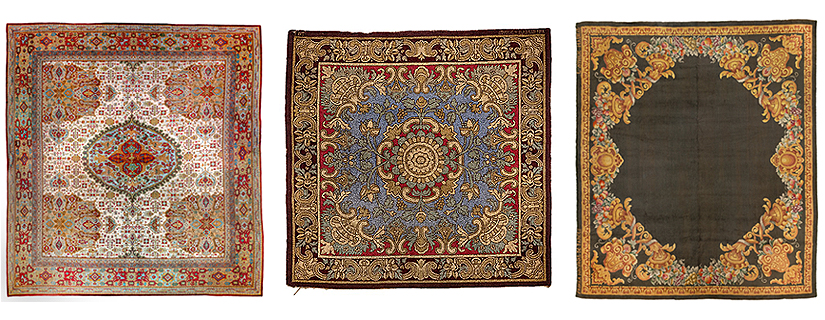 Real Fábrica de Tapices - Fábrica Nacional de Tapices ['Royal Tapestry Works - National Tapestry Works']: Rug (1900-1925) | Rug (1934) | Rug (1931-1939)
Real Fábrica de Tapices - Fábrica Nacional de Tapices ['Royal Tapestry Works - National Tapestry Works']: Rug (1900-1925) | Rug (1934) | Rug (1931-1939)
Along with these items made by the Real Fábrica de Tapices, the initial selection of works featured in the new section on rugs also includes three more valuable pieces. Two of them were produced by the former Fundación Generalísimo Franco ['General Franco Foundation'], which, in 1978, after the general’s death was renamed Fundación de Gremios Industrias Artísticas Agrupadas ['Foundation of Guilds & Associated Artistic Industries']. One is a rug with a classical, snake-like pattern on its border that evidences the interest shown in Spain at that time in the history of antique Spanish rug making; the other is a rug designed specifically for the Banco de España, possibly for the branch office in Huelva, as evidenced by the initials 'BE'.
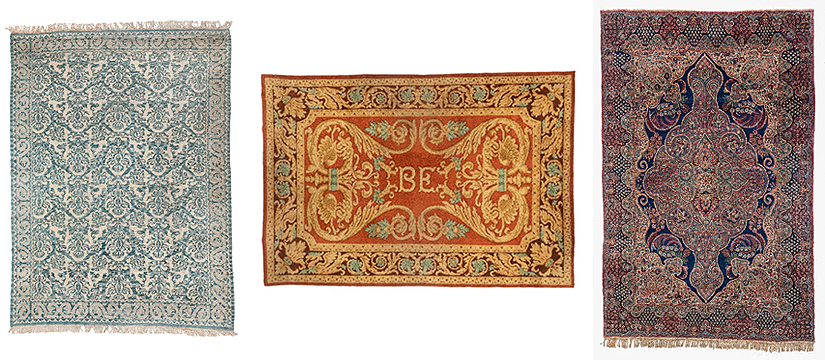 Fundación Generalísimo Franco - Fundación de Gremios Industrias Artísticas Agrupadas: Rug (1942-1984) | Rug (1962-1982) / Workshop in the city of Kerman: Rug (c. 1930)
Fundación Generalísimo Franco - Fundación de Gremios Industrias Artísticas Agrupadas: Rug (1942-1984) | Rug (1962-1982) / Workshop in the city of Kerman: Rug (c. 1930)
The last piece featured is a beautiful and interesting oriental rug made with asymmetric knots. It originates from the city of Kerman, in what is now south-east Iran, which has been closely associated with Persian rug making for centuries. Its large medallion and general decoration mean that it probably dates from the 1930s. Antonio Sama explains that, in the Farsi nomenclature used for such rugs, this piece is in the Golestan style, which means that its main decorative motifs are flowers. The brightness and delicacy of its colours is evidence that they are still natural. Sama argues that otherwise it would be impossible 'to attain the richness of colour' shown by the indigo field of the medallion.
